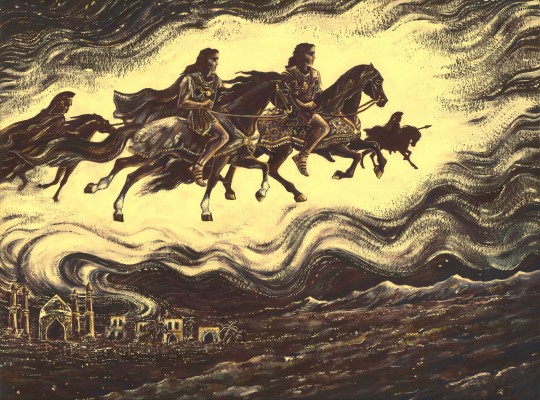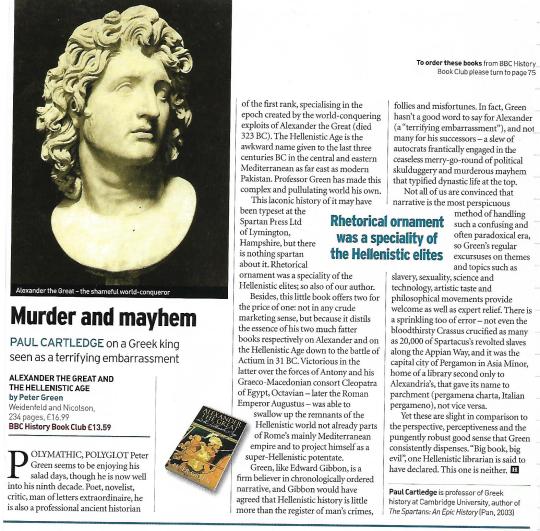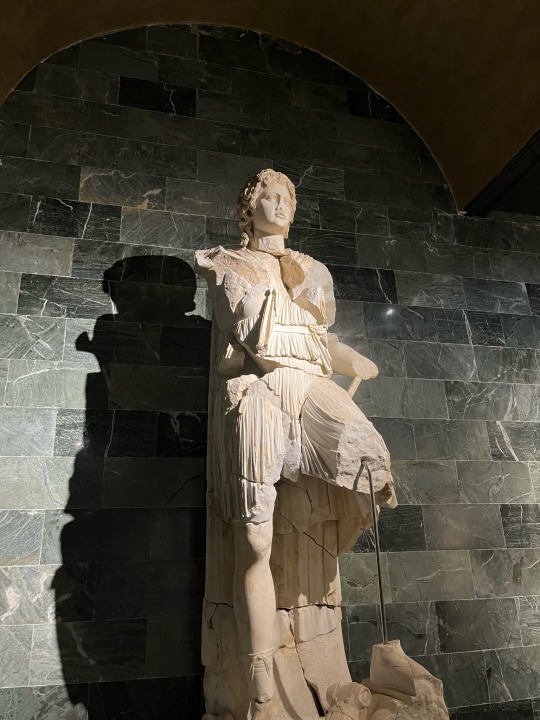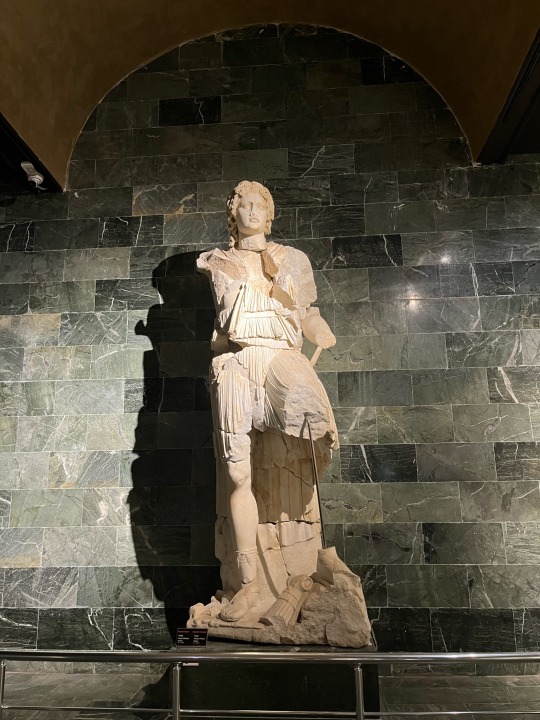#alexanderTheGreat
Explore tagged Tumblr posts
Photo

This map illustrates the state of the Macedonian Kingdom at the time of Philip II's death in 336 BCE, a powerful and unified state in northern Greece, poised to dominate the ancient world. Through military reform, strategic diplomacy, and alliances, Philip expanded Macedon’s territory, securing its hegemony over Greece and preparing the groundwork for his son, Alexander, to launch his conquests...
33 notes
·
View notes
Text

Spirits of ancient battles. Memories of Alexander the Great (2023/2024)
Gouache version of the work from 2017: https://www.tumblr.com/marysmirages/686070565494259712/spirits-of-ancient-battles-memories-of-alexander?source=share
#alexanderthegreat#hephaestion#hephaistion#alexander of macedon#marysmirages#asia#ancient greek mythology#painting#art#horse#rider#mirage#oasis#persia
480 notes
·
View notes
Text

Kings and Their Lovers
Male Kings and Their Homoromantic or Erotic Relationships from Antiquity to Modern Times History offers numerous examples of male rulers who had homoromantic or erotic relationships with other men. These connections were often complex and influenced by cultural, societal, and personal factors. Here are some remarkable examples:
Antiquity
Alexander the Great (356–323 BC) The Macedonian king and famous conqueror had a particularly close relationship with Hephaestion, his childhood friend and confidant. Plutarch described Hephaestion as "Alexander's lover." After Hephaestion's death, Alexander was inconsolable and ordered a nationwide mourning. The Persian eunuch Bagoas is also mentioned in ancient sources as Alexander's lover.
Emperor Hadrian (76–138 AD) The Roman emperor is known for his passionate relationship with the young Greek Antinous. When Antinous drowned in the Nile, Hadrian was devastated. He had his lover deified, founded the city of Antinoopolis, and erected statues of Antinous throughout the empire. These actions testify to Hadrian's deep affection and grief.
Middle Ages
Richard the Lionheart (1157–1199) Richard I of England had a close relationship with Philip II of France. Contemporary chroniclers described how the two kings "ate from the same table and drank from the same cup every night" and "slept in the same bed." Although the exact nature of their relationship remains disputed, such reports suggest a very intimate connection.
Edward II of England (1284–1327) Edward II had an intense relationship with Piers Gaveston, which chroniclers of the time described as excessively intimate. Later, he developed a similarly close relationship with Hugh Despenser the Younger. These connections led to political tensions and ultimately contributed to Edward's deposition.
Modern Times
James I of England (1566–1625) James, also known as James VI of Scotland, had several close relationships with men. Particularly notable was his connection with George Villiers, the Duke of Buckingham. In letters, James called Villiers "my sweet child and wife" and "my dear Venus boy." This correspondence indicates a passionate and intimate relationship.
Louis XIV of France (1638–1715) Although the Sun King is primarily known for his female mistresses, there are indications of intimate relationships with men. The Duke of Saint-Simon reported in his memoirs of several homosexual affairs at court, including one between Louis and his brother Philippe, Duke of Orléans.
Frederick the Great of Prussia (1712–1786) Frederick had close relationships with several men, particularly Hans Hermann von Katte in his youth. Although Frederick married, the marriage remained childless and distant. Instead, he surrounded himself with a circle of close male friends and confidants.
Ludwig II of Bavaria (1845–1886) Known as the "Fairy Tale King," Ludwig II had close and presumably romantic relationships with several men. Particularly well-known are his connections to Richard Hornig, his stable master, and Paul von Thurn und Taxis. Ludwig's homosexuality was an open secret during his lifetime and contributed to the accusations that led to his dethronement.
Modern Era
Tsar Nicholas II of Russia (1868–1918) Although later married, the last Russian Tsar had a close relationship as a young man with his cousin, Prince Nicholas of Greece. In letters, he described their "special friendship" and the "wonderful nights" they spent together.
These examples show that same-sex relationships among rulers were not uncommon. The nature and perception of such connections varied greatly depending on the cultural and historical context. While some relationships were lived relatively openly, others remained hidden due to societal norms and political implications or were only hinted at in documentation.
It is important to note that modern concepts of sexual orientation and identity cannot be directly applied to historical figures. Many of these rulers would not have identified themselves as homosexual or bisexual, as these terms did not exist in their time. Their relationships must be understood in the context of their respective culture and time.
Nevertheless, these historical examples offer important insights into the diversity of human relationships and show that same-sex love and affection existed even at the highest levels of power.
Text supported by GPT-4o, Claude AI
Image generated with SD1.5. Overworked with inpainting (SD1.5/SDXL) and composing.
#History#LGBTQHistory#AlexanderTheGreat#Hephaestion#Hadrian#Antinous#RichardTheLionheart#EdwardII#JamesI#LouisXIV#FrederickTheGreat#LudwigII#NicholasII#QueerHistory#SameSexRelationships#Monarchs#RoyalLovers#HistoricalFigures#HumanRelationships
24 notes
·
View notes
Text
New Covers are Here!
New covers! Need a Christmas or Hanukkah gift for the history-lover in your life? Or even just for yourself?
Get these stunning new covers with revised content.
Blurbed by none other than Kate Elliott.
PLEASE REPOST & BOOST!


#alexanderthegreat#hephaistion#ancienthistory#historicalfiction#olympias#classics#tagamemnon#Hephaestion#alexander the great#philip of Macedon#ancient macedonia#ancient history#dancing with the lion#dwtl
19 notes
·
View notes
Text

The ancient city of Pergamon in present-day Turkey was founded in the 3rd century BC by one of Alexander the Great's generals. In 133 BC control of the city passed to the Roman Republic.
3 notes
·
View notes
Text

ALEXANDER THE GREAT
#alexanderthegreat
2 notes
·
View notes
Text

Doodle of Sculptures | Pencil Crosshatching
#pencil drawing#crosshatching#ancient art#ancient greece#mature lady#alexanderthegreat#sculpture#doodle#art#traditional drawing#traditional sketch#drawing#artists on tumblr
2 notes
·
View notes
Text

2 notes
·
View notes
Text

A recent docuseries released on Netflix, Alexander: The Making of a God, has ignited controversy among conservatives due to its depiction of Alexander the Great as a gay man.
Full Story Here: https://uinterview.com/news/conservatives-challenge-netflixs-portrayal-of-alexander-the-great-as-a-gay-man-in-new-docuseries/
2 notes
·
View notes
Text




Alexander the Great, Perge
2 notes
·
View notes
Text
Scientists make new claims in search of Alexander the Great's tomb!
A new possible location for the tomb of Alexander the Great. Preliminary research into a mysterious tomb in Syria has yielded historically important artefacts.
Alexander the Great was one of the most iconic figures. Who shaped the course of world history. Despite his many contributions to history, his life ended tragically at a young age! But there is a lot of confusion among expert historians, archeological treasure hunters and history buffs about Alexander. It was such a confusing thing that his tomb scientists finally found the tomb of Alexander the Great. Where this mighty warrior was buried and why it took so long to find it - these mysteries will be revealed in our video today! Know More...
youtube
#searchengine#alexanderthegreat#alexanderthegreatbanglabiographyinbangla#youtube#bangladesh#tumbirfyp#search engine#Youtube
2 notes
·
View notes
Photo

Julius Caesar: The Faults Behind the Myth
Last March marked the anniversary of Julius Caesar's assassination over 2,000 years ago, and after two millennia, his legendary achievements still linger in today's consciousness just as they have for centuries. He was so revered that in Dante's Inferno, his conspirators shared the lowest circle of hell with Judas Iscariot, labeling them the worst sinners in history. Even Alexander Hamilton claimed, “The greatest man who ever lived was Julius Caesar.” Could he really have been that great?
Early signs of his personality
Caesar was born in the slums of Rome even though he traced his lineage to the city's noble forbears and even claimed to be a descendant of the goddess Venus. Through his brilliance, tenacity, and perpetual willingness to become overwhelmed with debt, he was able to climb the political ladder, called the cursus honorum, and reach the pinnacle of power.
But the faults lingering beneath Caesar's charismatic veneer were evident very early in his life. After he was captured by pirates, ransomed, and released, he sought revenge, with good reason. He seized the pirates and turned to the Roman provincial governor to mete out justice. When he was unhappy with their sentence of slavery, he defiantly had them all crucified. Not long after, he was once again dissatisfied, this time with Rome's reaction to a threat posed by the belligerent King Mithridates. Instead of coordinating with Roman officials or even acquiring permission, he insubordinately led troops against the Mithridatic allies.
Continue reading...
33 notes
·
View notes
Text
👑 Unveiling the Complexities of Alexander the Great's Life 👑
🌈 Today on his birthday, let's delve into the fascinating world of Alexander the Great, a legendary figure whose conquests reshaped history. Beyond his military prowess, there's a captivating aspect of his life that often sparks intrigue: his bisexuality. Let's explore this lesser-known facet: 🛡️ Born in 356 BCE, Alexander III of Macedon, better known as Alexander the Great, was a military genius and one of history's most influential leaders. 💕
Alexander's bisexuality was an integral part of his identity. He had deep emotional and physical connections with both men and women. 🔥 One notable relationship in Alexander's life was with his companion and close friend, Hephaestion. Their bond was profound and enduring, often described as a romantic partnership. Hephaestion held immense influence in Alexander's life, accompanying him on his conquests and serving as a trusted advisor. 🌍
Alexander's inclusive attitude extended beyond his personal relationships. During his reign, he promoted cultural exchange and adopted customs from various conquered territories. This approach fostered tolerance and acceptance of diverse traditions, including different expressions of love and sexuality. 👑
Today, we honor the legacy of Alexander the Great, not just for his military achievements, but also for the way he defied societal norms and embraced the diversity of human connections. Let's celebrate the vibrant tapestry of identities that have shaped our world throughout history.
3 notes
·
View notes
Text

Alexander the Great and Hephaestion
A Legendary Love Amidst Fame and Conquests
In the history of antiquity, few figures are as famous as Alexander the Great, the undisputed conqueror who created one of the largest empires in history. Born in 356 BC, Alexander shaped the ancient world like few other rulers. Yet, alongside his military glory and political achievements, there was a central relationship in Alexander’s life that was closely tied to his identity and rise: his bond with his closest friend and lover, Hephaestion. Their connection was not only of strategic and military value but also a deep personal and emotional bond that lasted for decades.
The Formation of an Inseparable Friendship
Alexander and Hephaestion met in their youth while both were students of the philosopher Aristotle. They quickly developed a close friendship that, over time, formed into a deep emotional connection. While Alexander shone with his extraordinary military prowess and charisma, Hephaestion was known for his wisdom and unwavering loyalty.
Their relationship went beyond friendship and, according to common historical interpretations, also took on a romantic dimension. Historians point to many clues that suggest Alexander and Hephaestion shared a homoromantic relationship, similar to the idealized “bonds of love” between men in Greek culture. Such relationships were not unusual at the time, especially among soldiers and warriors who spent long campaigns together.
Hephaestion: Alexander’s Closest Confidant and General
Hephaestion played not only an important role in Alexander’s personal life but was also a high-ranking general in his army. He fought in many significant battles alongside Alexander, including the decisive battles of Gaugamela and Issus, which greatly expanded Alexander’s empire. As Alexander’s closest confidant, Hephaestion was entrusted with military and diplomatic tasks and enjoyed Alexander’s unwavering trust.
Their close collaboration on the battlefield and in political decisions highlighted their inseparable bond. Hephaestion was one of the few who stood beside Alexander in nearly all aspects of life – as a friend, lover, and general.
The Immortal Love: Hephaestion’s Death and Alexander’s Grief
When Hephaestion suddenly died in October 324 BC, Alexander was devastated. The loss of his closest companion was a deep emotional blow for the otherwise unshakable conqueror. Alexander held a monumental funeral for Hephaestion, bestowing divine honors upon him. He named cities in Hephaestion’s honor and even wanted him to be worshipped as a god after his death.
Alexander’s deep grief reveals how strong his emotional bond with Hephaestion was. It is reported that he could not find peace for months and never fully recovered from the pain of the loss until his own death a year later. Many historians believe that Alexander was never truly the same after Hephaestion’s death.
The Significance of Their Relationship in History
The relationship between Alexander the Great and Hephaestion is one of the best-documented examples of a close, possibly romantic, connection between two men in the ancient world. Although there are no explicit accounts of the nature of their relationship, many clues and Alexander’s reaction to Hephaestion’s death suggest that their bond was more than just an ordinary friendship.
In a time where power, fame, and conquest meant everything, Hephaestion provided Alexander with the emotional stability he needed to pursue his great ambitions. Their love – whether romantic, fraternal, or a mixture of both – stands as a symbol of the importance of loyalty, friendship, and affection amidst the constant struggle for power and glory.
The Complexity of Ancient Relationships
It is important to note that despite his close relationship with Hephaestion, Alexander also married women. He wed Roxana, a Bactrian princess, and Stateira, a daughter of the Persian King Darius III. These marriages often served political purposes and were part of his strategy to consolidate and expand his empire. The coexistence of these marriages with his relationship to Hephaestion highlights the complexity of ancient relationships and social expectations.
Legacy in Art and Literature
The relationship between Alexander and Hephaestion has inspired artists and writers over the centuries. In the Renaissance and modern times, their story has often been depicted in paintings, sculptures, and literary works. One of the most famous pieces is the painting "Alexander and Hephaestion" by Charles Le Brun from the 17th century. In modern literature, authors such as Mary Renault have explored the depth and complexity of their relationship in historical novels. These artistic interpretations help keep the legacy of their bond alive and underscore its enduring cultural significance.
Text supported by Claude 3.5 Sonnet Base images generated with DALL-E, overworked with SD-1.5/SDXL inpainting and composing.
#GreekMythology#AncientLegends#Soulmates#manlovesman#gayart#LGBT#AlexanderTheGreat#Hephaestion#LGBTQHistory
18 notes
·
View notes
Text
Instead of just writing out how to say it, now you can HEAR me say it, and explain the variations, including how his friends in Macedonia, growing up, would have pronounced his name (probably not the same way his father did).
Feel free to share.
And if anybody's curious as to the research behind my claim that his family was of Attic-Ionic extraction, see my article, "Becoming Macedonian," Karanos 3 (2020): 11-37, with attendant digital mapping project.
#hephaistion#hephaestion#alexanderthegreat#classics#ancient macedonia#dancing with the lion#pronouncing ancient Greek#ancient Greek#ancient Greece#tagamemnon
14 notes
·
View notes
Text
REIGN: The Conqueror — Madhouse Studios’ Medieval Futurist Anime

Anime ahead of its time, REIGN: The Conqueror (アレクサンダー戦記 [Arekusandā Senki]) is a Madhouse Studios (One Punch Man, Death Note, Trigun) gem deep in its back catalog. Based on a novel by best-selling Japanese author 荒俣 宏 (Hiroshi Aramata), it’s the story of the rise and ensuing battle against Persia of the ancient world’s greatest emperor, Alexander the Great.
We’ve an engaging cast of characters which are all, at least in name and relation to him, accurate to ancient accounts. Onscreen are King Philip II of Macedon and his pagan queen Olympias, both rearing Alexander to one day assume the throne. Alexander finds adventure alongside many friends including Ptolemy I, his most trusted general of the fearsome and mighty Macedonian army. Carrying Alexander to victory is his famous black stallion war horse, Bucephalus, who takes down soldiers and assassins with golden armored mechanical muzzle and hooves. Also in this epic is Alexander’s personal tutor and famous ancient philosopher of the Western World, Aristotle, driving story subtext and plot. In fact, many memorable philosophers are there, such as the cynic-philosopher Diogenes “The Dog” and the ghost (or “essence”) of Plato.
One interesting dynamic to REIGN: The Conqueror is we never quite know if we’re watching the past or the future unfold. It subverts any familiar timeline, suspended in a surreal and timeless period where fantasy elements abound, such as shapeshifting spirit alchemist factions (like the Pythagorean Cult, bent on hopes to assassinate Alexander), cloud resident titans and elemental gods. While undercurrents of electricity and advanced technology are part of this world, battles are won by horse cavalries, swords, spears and shields. Landscapes are adorned with moving walkways and extreme architecture. Flying machines course the sky. This is medieval futurism at its best, and Madhouse Studios probably couldn’t have chosen a better art designer to create such hypnotizing and impossible juxtaposition. That animator’s name is Peter Chung, the very same Aeon Flux legend himself.
Perhaps none of the ethereal themes would have been so elegantly animated, or as moving and entertaining, without Peter Chung (IG: @peter_k_chung) at the helm of this multi-nation anime project. Chung’s animation is influential for many. Those less familiar with his work, you might be surprised to know his portfolio includes some of the best and most popular animation of the last 35 years. Notwithstanding his well-known MTV series, Aeon Flux, his animation and collaboration is responsible for the original Transformers TV show, the title opening sequence for Teenage Mutant Ninja Turtles, and also co-designing Nickelodeon’s Rugrats. Chung’s art direction and contribution is part and parcel to the stunning visual imagery and magic you experience in REIGN: The Conqueror.
I could imagine this 13 part series landing perfectly among today’s anime and post-Game-of-Thrones era. But it aired on WOWOW and Adult Swim a little too ahead of its time in ’99 and ’03. REIGN: The Conqueror challenges watchers to sit back and enjoy the beauty of anime that’s packed with style and memorable story, makes you feel anime in a visceral way. It will surprise and intrigue you.
Enjoy the series on YouTube here!
JEFFREY WELLS | Writer
POP-COOLEDTURED SPECIALIST
818–394–0023 | cooledtured.com | [email protected]
#anime#animes#animeseries#animeworld#otaku#animefans#animation#animationseries#madhouse#madhousestudios#reigntheconqueror#peterchung#mtv#mtvliquidtelevision#liquidtelevision#adultswim#wowow#youtube#alexanderthegreat#medievalfuturism#medievalfuturist#art#drawing#onepunchman#deathnote#trigun#aeonflux#transformers#teenagemutantninjaturtles#rugrats
2 notes
·
View notes